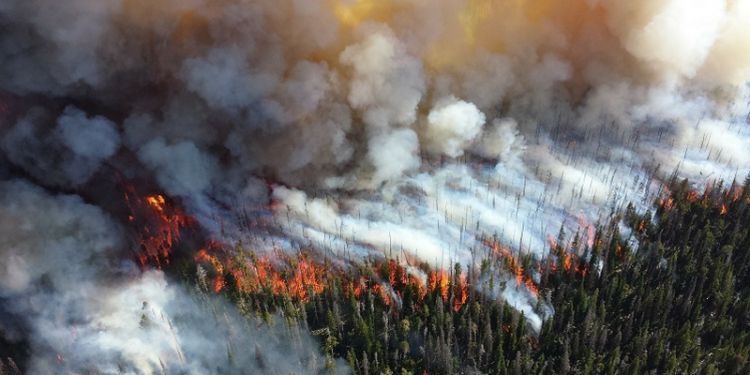Lightning is the leading cause of wildfires in boreal forests, threatening carbon storage

New research shows that lightning is the biggest threat to boreal forests and that its frequency will increase with climate change.
The research was co-authored by Dr Declan Finney in the School of Earth and Environment, who collaborated with researchers from Vrije Universiteit Amsterdam (VU), Jiangsu Academy of Agricultural Sciences, the University of East Anglia (UEA) and BeZero Carbon Ltd.
Machine learning predicts the sources of wildfires
The study used machine learning to predict the main sources of wildfire ignitions – human or ‘natural’ lightning ignitions – in all world regions. They used data from seven regions to optimise the predictions from the algorithm.
The researchers say it’s the first study to attribute fire ignition sources globally.
The study shows that 77 per cent of the burned areas in intact extratropical forests are related to lightning ignitions, in stark contrast to fires in the tropics, which are mostly ignited by people.
Intact extratropical forests are those in an almost pristine state, with small human populations and low levels of land use. They are primarily found in remote boreal forests.
Increased lightning frequency
Climate models were also used to investigate how lightning frequency will change as the planet warms.
Lightning frequency was found to increase by 11 to 31 per cent per degree of global warming over intact extratropical forests, meaning that climate change brings a risk of more wildfire ignitions.
Lightning fires are on average larger, more intense and more strictly constrained to remote areas and periods of extreme fuel dryness than fires caused by humans.
The team’s earlier work has shown that episodes of fire-prone weather are becoming more frequent and intense as the climate warms, meaning that forests are more flammable.
This flammability alongside the increased lightning frequency is a worrying sign that intact extratropical forests will face an increasing threat of wildfire in future.
Dr Finney is an expert in lightning and climate change. He said:
"This work highlights the important role lightning can play in ecosystems and Earth's carbon stores. We often think of lightning in terms of its impact on humans. However, lightning is also important in regions largely absent of human influence where it's the dominant wildfire ignition source.
“In these remote regions, particularly in boreal forests, lightning can trigger wildfires and lead to additional greenhouse emissions.”
Extratropical forests store vast amounts of carbon
Extratropical forests are globally significant because they store vast quantities of carbon in vegetation and permafrost soils.
Approximately 91 per cent of these forests in the northern hemisphere are underlain by permafrost.
When fires occur in these regions, they emit large amounts of carbon dioxide (CO2) and other greenhouse gases compared to other regions.
Despite occupying only around 1 per cent of Earth’s land surface, fires in intact extratropical forests emit more than 8 per cent of the total CO2 emissions from fires globally.
It’s estimated that fires may amplify emissions of greenhouse gases from permafrost thaw by 30 per cent by the end of the century, following a moderate emissions scenario.
Dr Matthew Jones, Research Fellow at the University of East Anglia whose work focuses on the carbon cycle and climate change, said: “Extratropical forests are globally important because they lock up dense stores of carbon in vegetation and soils, helping to keep CO2 out of the atmosphere and moderate global warming.
“However, when fires occur in these regions, they emit more CO2 per unit area than virtually anywhere else on Earth.
“Our research highlights that extratropical forests are vulnerable to the combined effects of a warmer, drier climate and a heightened likelihood of ignitions by lightning strikes.
“Future increases in lightning ignitions threaten to destabilise vast carbon stores in extratropical forests, particularly as weather conditions become warmer, drier and overall more fire-prone in these regions.”
Record-breaking fire season
The research is particularly timely given Canada’s record-breaking fire season in 2023 when fire emissions were more than four times greater than the 2003-2022 average. Preliminary reports have indicated widespread lightning ignitions in Canada this year.
VU’s Dr Thomas Janssen, lead author of the study, said: “While our research did not focus specifically on this year’s extreme fire season in Canada, it does help us to understand this year’s events.
“Extreme fire seasons in boreal forests, like the one we saw in Canada this year, will be more likely in warmer climates due to hotter, drier weather and more lighting strikes.”
The authors warn that greenhouse gas emissions from fires can contribute to rising concentrations of carbon in the atmosphere and drive additional warming, further exaggerating the likelihood of fires and other adverse impacts of climate change in future.
Professor Sander Veraverbeke of VU said: “Increased greenhouse gas emissions from wildfires reinforces the problem of climate change, with more fires occurring as the climate warms and more greenhouse gases being emitted by fires.
“This ‘reinforcing feedback’ is particularly important in boreal forests, most of which are underlain by carbon-rich permafrost soils that take many thousands of years to form if they are lost to fire.”
Climate feedback processes previously overlooked
Dr Finney said, “The research here, along with other recent research, makes us think beyond the tropics as the main region affected by lightning.
“Looking closer to the poles is raising concerns that there may be climate feedback processes previously overlooked.
“Predicting how lightning will respond to climate change is highly uncertain, but results here should be taken seriously because evidence to date has consistently predicted increased lightning in boreal and more polar regions."
‘Extratropical forests increasingly at risk of lightning fires’ was published on 9 November 2023 in Nature Geoscience.




